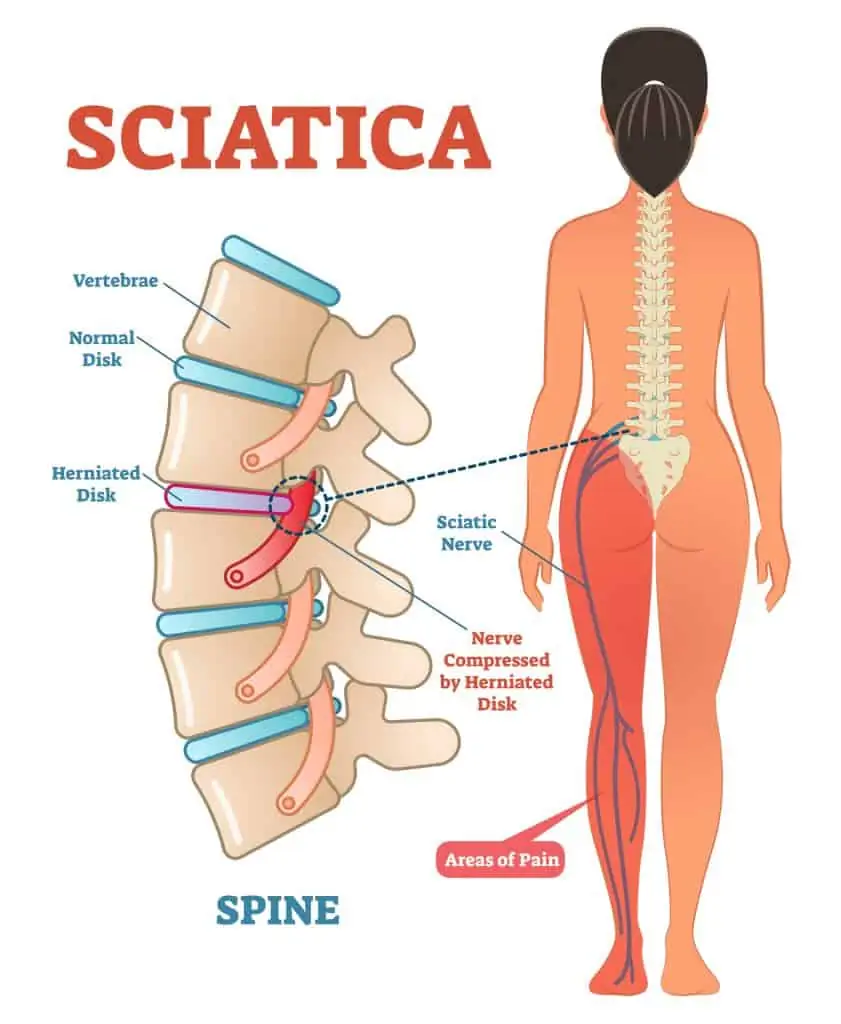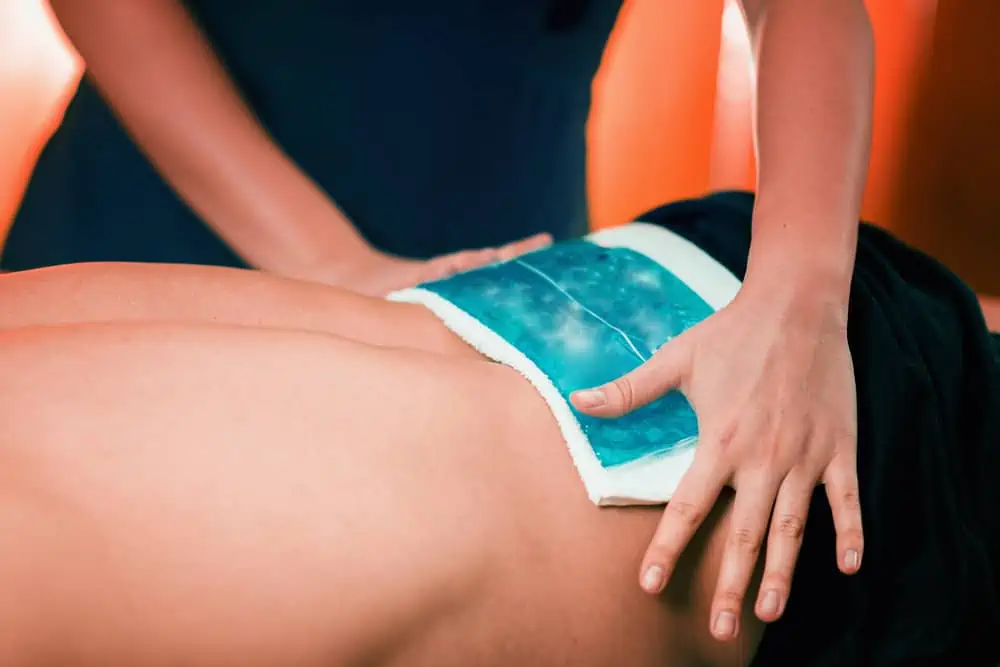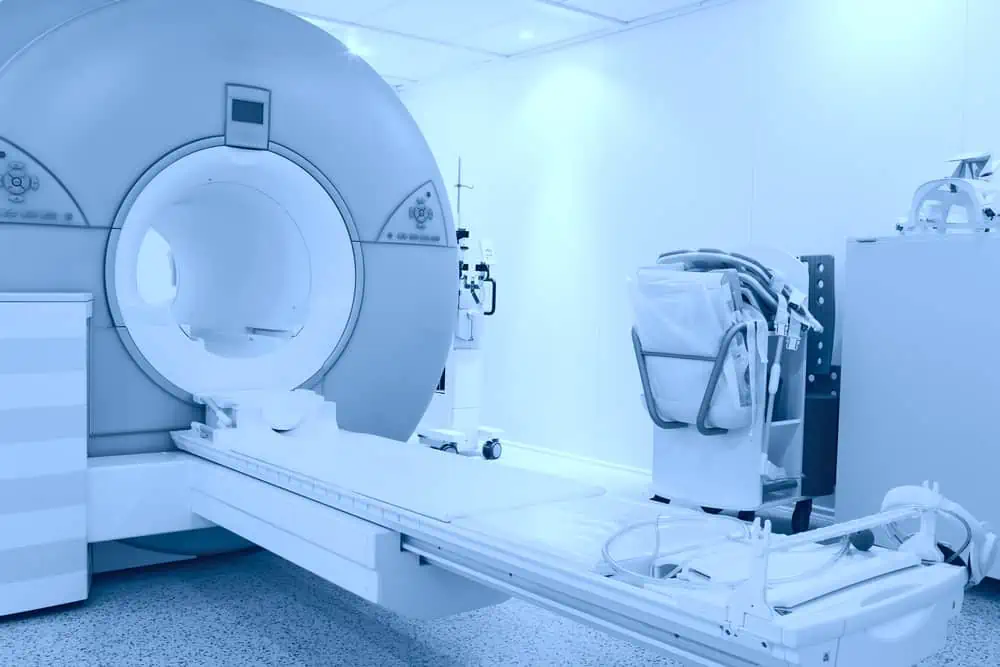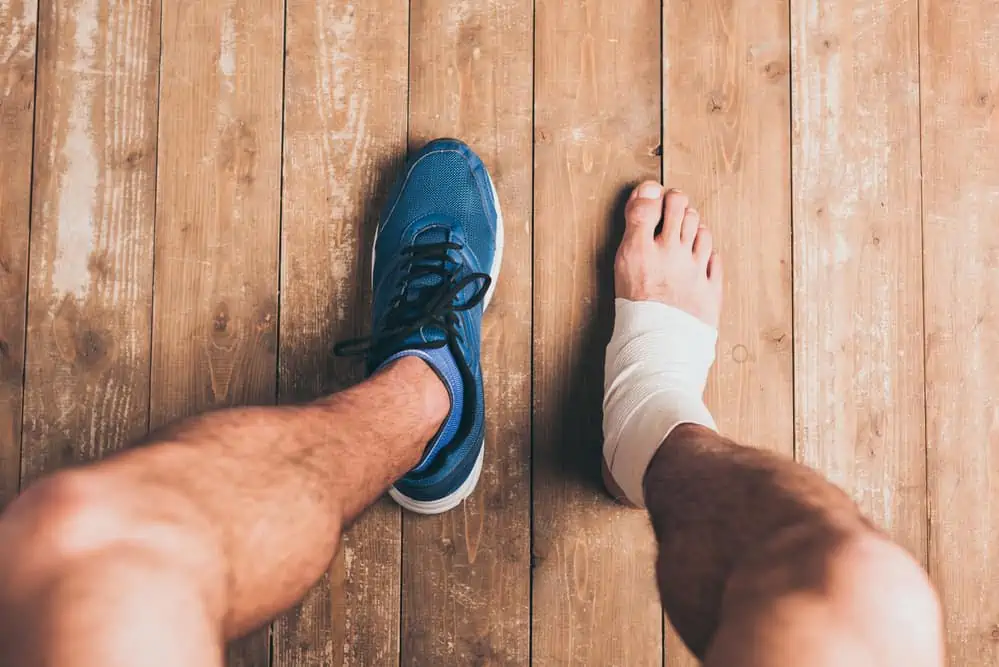This post may contain affiliate links. If you click through a link and make a purchase, I may receive a commission at no additional cost to you. As an Amazon Associate, I earn from qualifying purchases. Read the full disclosure here.
Have you ever found yourself in the thick of sciatic pain, wondering if ice or heat will help take the edge off?
But which is better, ice or heat for sciatica?
That’s exactly what we’ll talk about today, plus some additional tips you need to know to start feeling better.
Disclaimer: This content is for educational purposes and is not medical advice. Read the full disclaimer.
What is sciatica?
Sciatica is often oversimplified, and unfortunately, this contributes to the spread of misinformation.
People are quick to call almost any pain down the back of the leg “sciatica” without further teasing out the details.
The term sciatica is not a diagnosis but rather a description of a symptom (irritation of the sciatic nerve), and used by itself is rather vague.
Technically, sciatica refers to any irritation of the sciatic nerve along its path.
Many sciatica pain cases originate from the spine, such as with a disc bulge, causing inflammation of the lower spinal nerves (lumbar radiculopathy). This is sometimes referred to as a pinched nerve or sciatic nerve root pain.
Teasing out why you have sciatica is essential in getting the proper exercises to start feeling better.

Causes of sciatica
Here are some additional causes of sciatica nerve pain and conditions that can produce sciatic-like pain to consider.
Each of these would require a different approach, so it’s impossible to generalize sciatica pain treatment. For example, the appropriate therapeutic exercise program for a herniated disc will be different than the treatment of a muscle spasm or SI joint issue.
- Lumbar herniated disc (slipped disc)
- Impingement at the lumbar nerve root
- Muscular spasm
- SI joint issues
- Piriformis syndrome
- Sciatic nerve compression
- Pregnancy
- Spinal stenosis
- Degenerative disc disease
- Spondylolisthesis
- Arthritis
- Limited hip mobility
- Trauma
- Malignancies or infections
Conditions such as vascular disease or peripheral neuropathy can mimic sciatic symptoms but are very different conditions.
Hamstring strains can also be mistaken for sciatic nerve pain, but a proper evaluation by a doctor or physical therapist will tell them apart.
It’s also possible for multiple conditions to coexist, making diagnosis and treatment a little more challenging.
Don’t miss this article outlining plenty of tips on what to avoid when you have sciatica.
Symptoms of sciatica
Sciatica symptoms vary in intensity and severity.
Some common symptoms of sciatica are:
- Moderate to severe lower back pain, back of the hip/buttock, and leg pain
- Sensation changes such as numbness, tingling, pins and needles, or prickly sensations
- Muscle weakness
- Pain and symptoms can be anywhere along the distribution of the sciatic nerve
If any of these symptoms are accompanied by loss of bowel or bladder function or numbness in the area where you would sit on a saddle, get to the doctor ASAP because that’s a medical emergency.
Ice or heat for sciatica?
This is usually one of the top questions whenever pain is involved. Let’s break down what each can do (as well as what they can’t do), so you can smartly use these modalities in your plan.
Benefits of cold therapy
Blood vessels respond to temperature changes. Ice constricts blood vessels and decreases circulation. This process can help to limit swelling in acute injuries.
The other major attraction to ice is pain reduction. The cold reduces nerve activity, produces a numbing effect, and is a localized, non-drug way to help manage pain following an injury.
Using ice for an injury can:
- Constrict blood vessels
- Decrease circulation
- Decrease swelling
- Decrease pain, muscle spasm, or itching
- Slow tissue metabolism
How to apply ice for sciatica
- Ice will have the most effect when applied to the root cause of the problem, which in many cases is the lower back/back of the hip
- Ensure there are no contraindications to using ice (precautions list at the bottom of this article)
- Always use a towel layer between your skin and the ice back to reduce the risk of injury
- Apply ice to the desired area for 10-20 min
- Ice can be used throughout the day as needed for a non-drug method of managing pain
Best ice packs for sciatica
Move over, tiny blue ice packs! Make sure you grab the same clinic-grade quality ice packs to keep on hand at home.
These ice therapy packs come in extra-large sizes, stay cool, and will last a long time. The larger size is also great for general low back pain.
Benefits of heat therapy
Superficial heat feels oh-so-cozy and can come from a microwave or water bath hot pack, heating pad, heat patch, hot water bottles, hot bath, or sauna.
- Increases blood flow
- Increase tissue metabolism
- Decreases feelings of pain, soreness, stiffness, and tight muscles
- Improve range of motion and mobility due to decreased perception of stiffness
If your pain isn’t an acute injury and you feel like the quality is more muscle soreness, stiffness, and tightness, then heat might feel good.
Liquids can also move easier in warm temperatures than in cold temperatures. Because heat can increase blood flow by dilating blood vessels, it has the potential to increase swelling, which may cause additional discomfort.
How to apply heat for sciatica
- Ensure there are no contraindications to using heat (precautions list at the bottom of this article)
- Follow the manufacturer’s directions for your desired method of heat (e.g. microwave hot pack, heat patch, etc.)
- Always use a towel layer between your skin and the ice back to reduce the risk of injury, more layers are needed if you will by lying on the mode of heat
- Apply heat to the desired area for 10-20 min
- Heat can be used throughout the day as needed for a non-drug method of managing pain
Best heat packs for sciatica
- Microwavable flaxseed hot pack with ties (also great for general low back pain)
- Revix microwavable heating pad
More to consider
Many physical therapists have become “anti-modalities” in recent years because the research is shown to be a little fuzzy.
While treatments have largely moved away from passive modalities, if a few minutes of ice or heat intermittently helps someone take the edge off of their severe pain or reduce the use of pain medication so they can get moving in active treatments that have more benefits, then that’s positive.
Ice and heat can both be natural pain management methods to help reduce the use of pain medication, especially when dealing with chronic pain. Both of these modalities can be helpful for short-term sciatica pain relief, but it’s important to distinguish what they can and can’t do.
While both ice and heat packs may help you decrease pain temporarily and get moving, remember that these modalities are passive.
Passive means nothing is required on your part, for example, ice, heat, kinesiology tape, massage therapy, etc. While these things might sound great or even be part of your recovery, using passive modalities only will not fix pain or injuries.
They can be helpful for temporary pain management, but applying ice for weeks and doing nothing else won’t help you heal. Falling into the trap of thinking these things alone will eventually “cure” you only prolong pain and dysfunction.
This is not meant to “shame” you if you love your hot pack. Everyone loves a little ice or heat every now and then. But there also needs to be an active component.
It’s essential to get evaluated for the root cause of your sciatic pain and get started on the appropriate treatment program. Physical therapy can also help you get moving in safe ways.
Precautions using ice and heat
Both ice and heat can cause damage if applied incorrectly. Here are some tips to make sure you stay safe when applying each.
- Always use buffer layers in between your skin and the ice/heat pack to reduce the risk of burns or frostbite
- Limit usage to 10-20 min at a time
- Check the skin every few minutes
- Don’t fall asleep using ice or heat
- Use extra layers between you and the ice/heat if you’re lying on top of the pack
- Caution using in areas with decreased sensation or with people who have impaired cognition
- Avoid heat over open wounds, stitches, or swelling
- Caution with circulation problems
Ice or heat for sciatic pain?
Grabbing an ice pack or heat pack in a pinch to get some sciatica relief is fine; just understand how these modalities fit into an overall treatment plan and their limitations.






